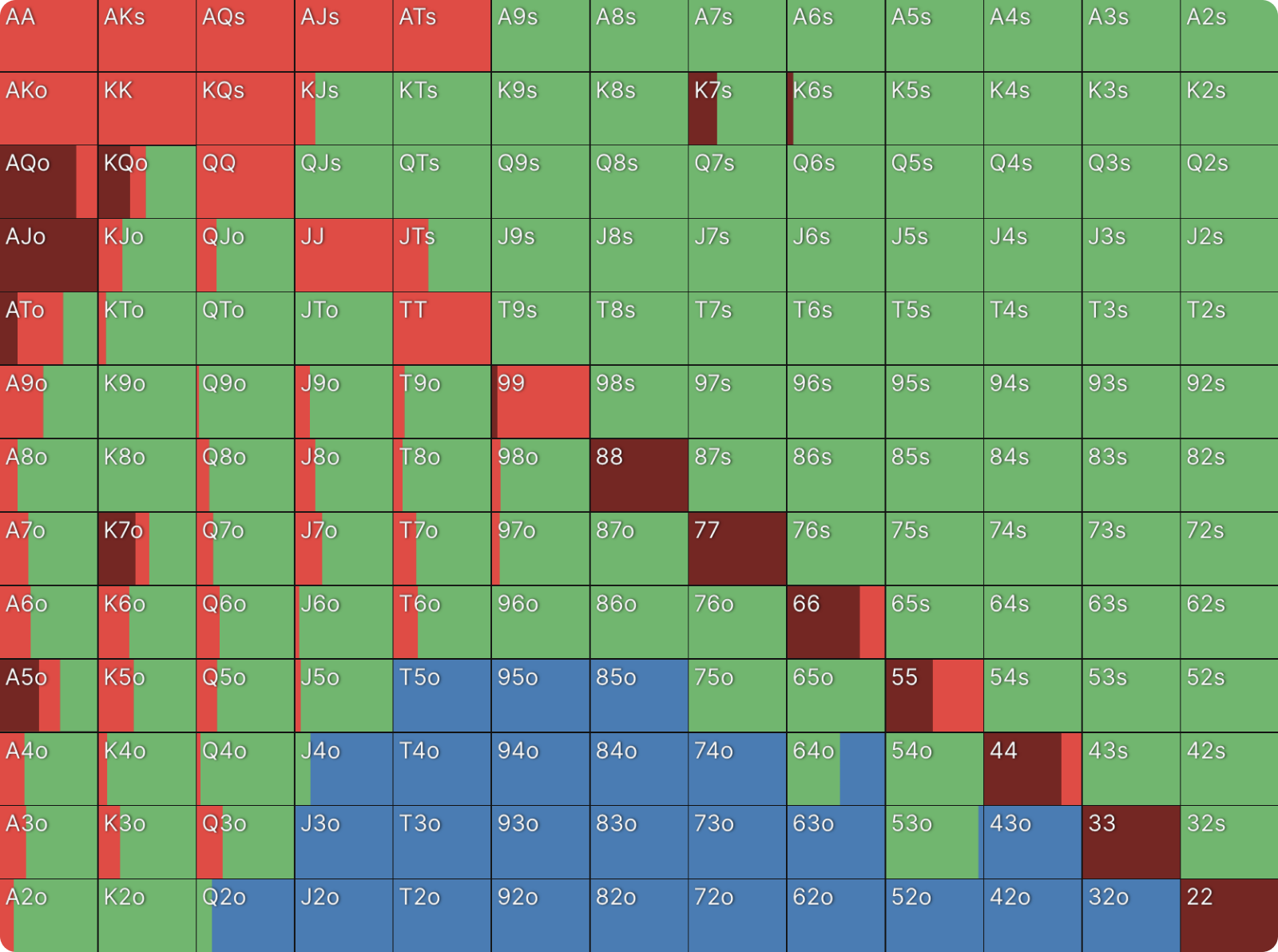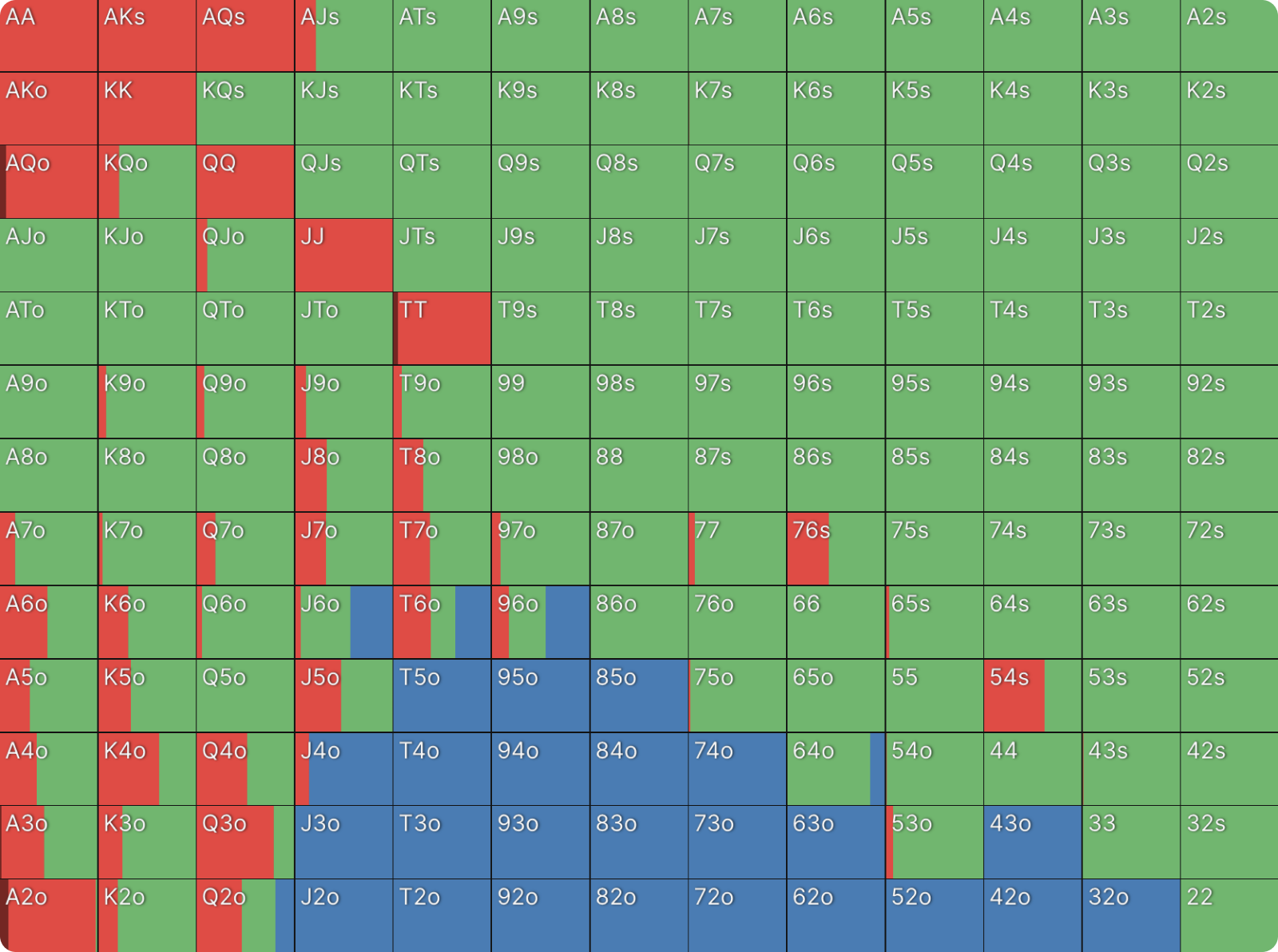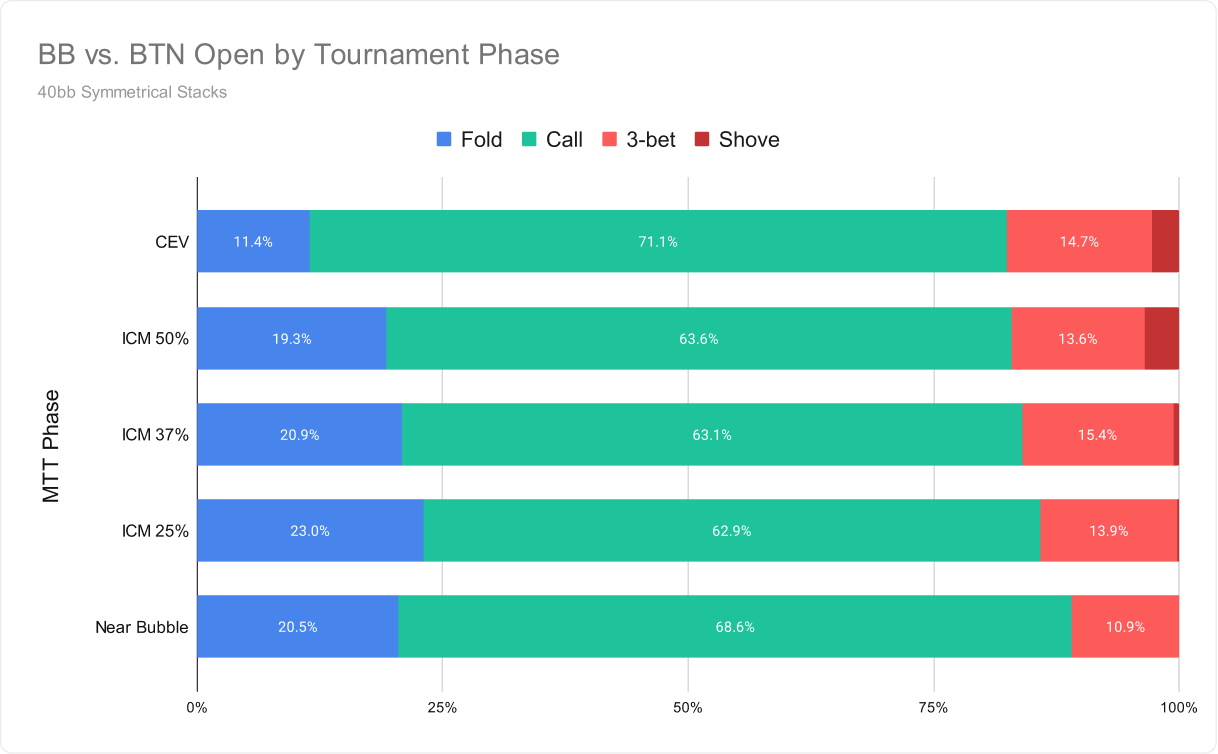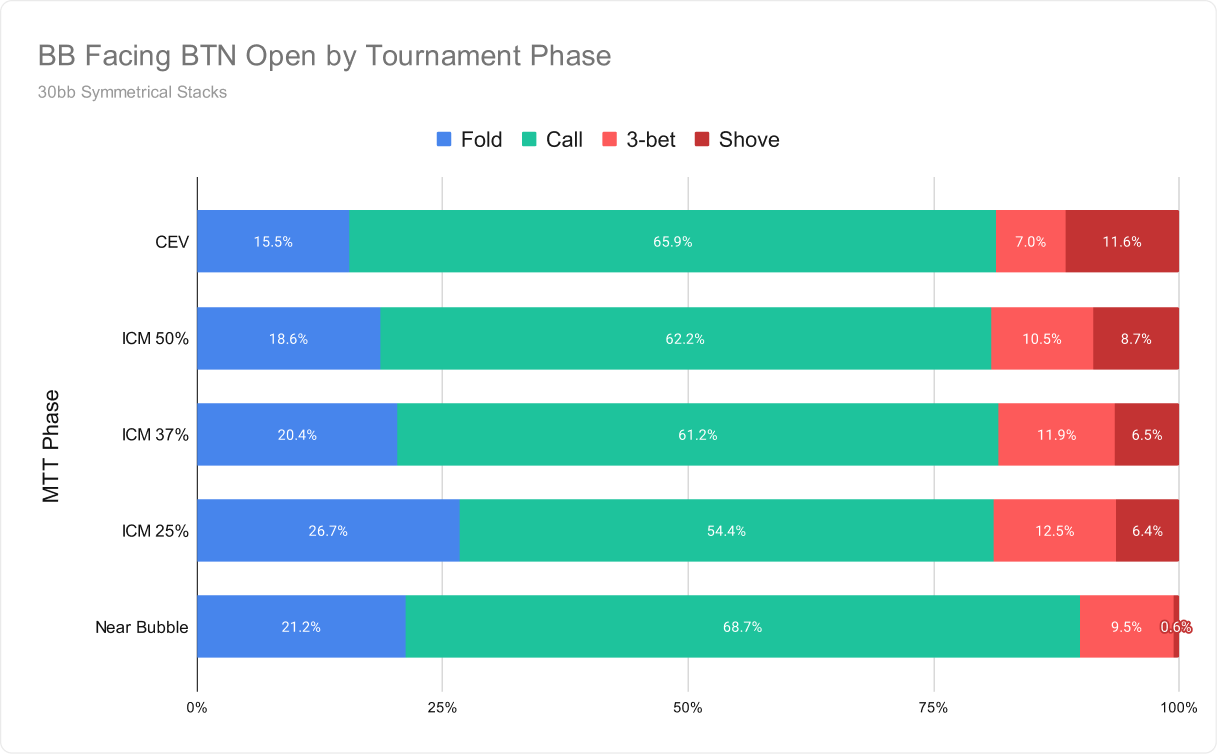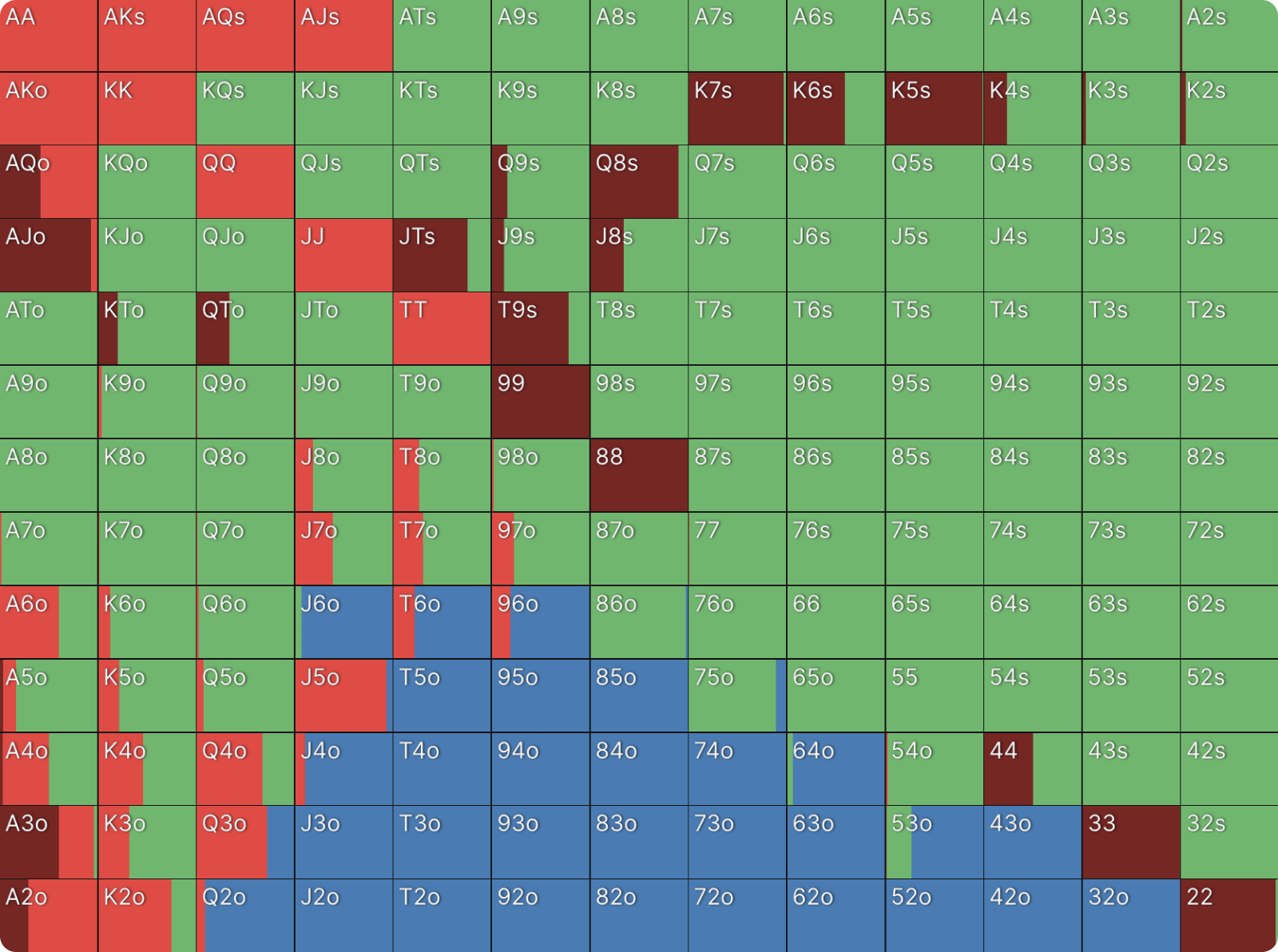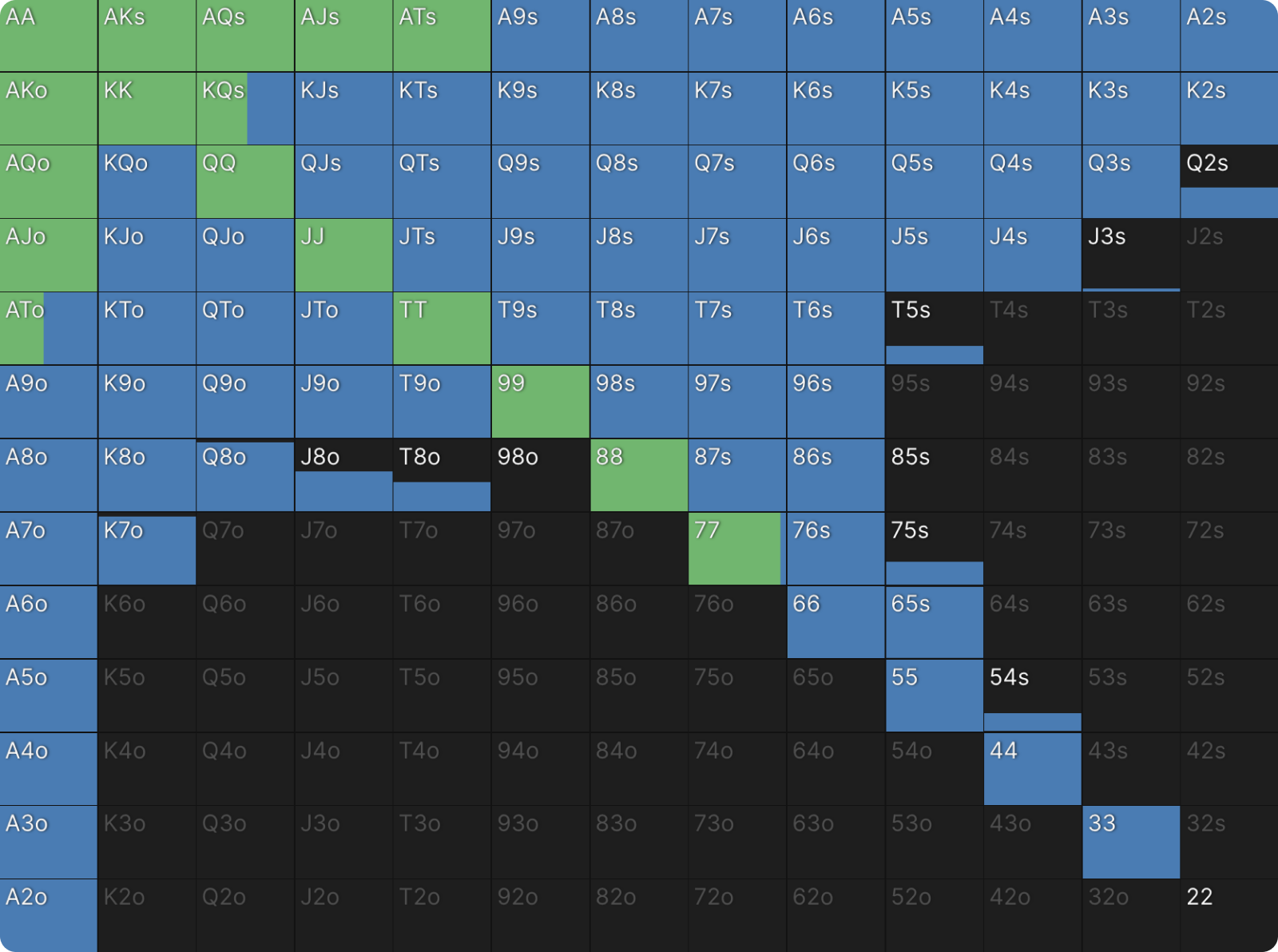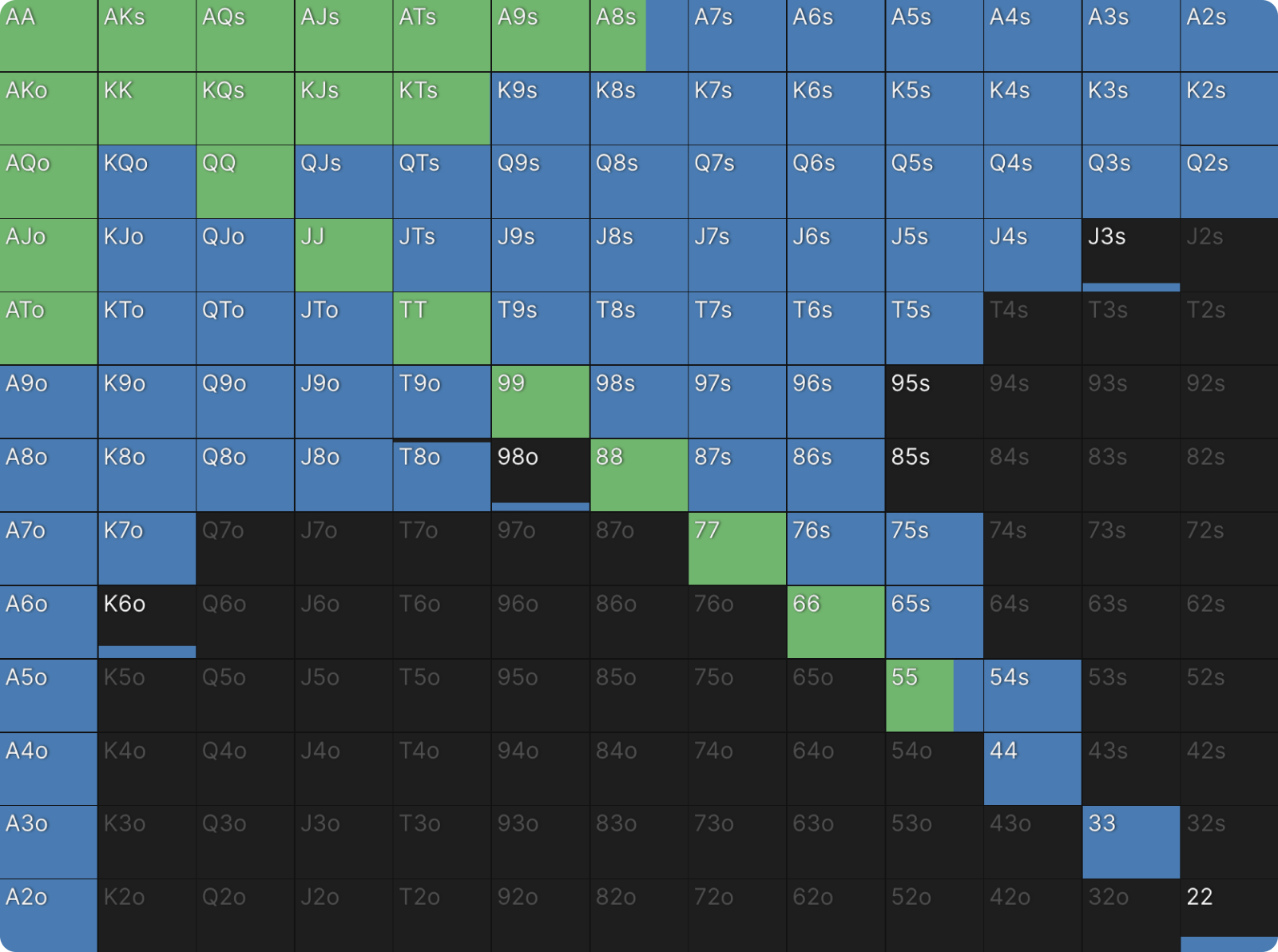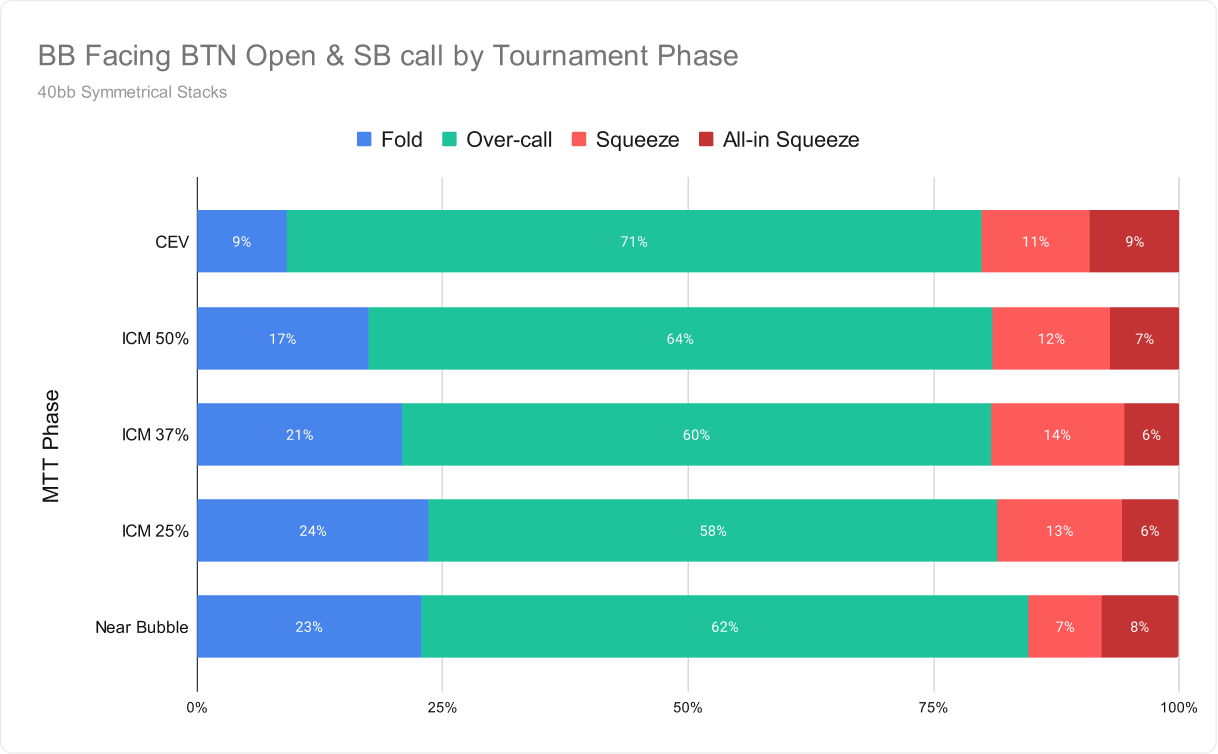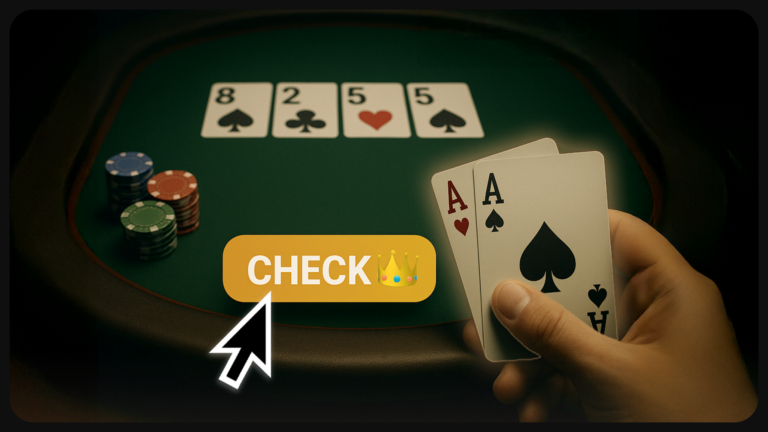How ICM Impacts Restealing From The Blinds

When I first started working with preflop solves, one of the features I found most striking was large preflop all-in bets into relatively small pots. Though not unheard of in the pre-solver era, these huge shoves were widely considered fishy, a crude compensation for lack of postflop skill. And in that era, they often were. The underlying principle is correct, however: in the right spot, with the right kind of hand, a big shove preflop is the optimal play, in no small part because of the difficulty of playing these hands after the flop.
These big shoves occur most often in late position when opponents’ ranges are widest (any two cards, in the case of blinds who have not yet acted). In such scenarios, it can be optimal to shove with hands too strong to raise-fold but not so strong they wish to induce action. This can incentivize a late position player to shove 20bb into an unopened pot or to shove 30bb or more over a late position “steal”. The blinds especially have an incentive to make these big shoves, as smaller raises would risk contesting a large pot out of position after the flop.
For example, here is the BB’s response to a 2.3bb BTN raise with 40bb stacks, using the Chip EV model.
The BB shoves 6% of hands with a clear preference for those with robust equity but poor postflop performance at a low SPR: small pairs, AQo, and AJo. These hands value the fold equity that comes from raising and are too strong to fold to a four-bet but not strong enough to want the extra action a smaller three-bet would induce.
While it may be fairly obvious what sort of hand you have when you make this shove, there is little your opponent can do about it.
While it may be fairly obvious what sort of hand you have when you make this shove, there is little your opponent can do about it: if they call with a tight range, these hands perform less well when called but win more pots without showdown. If they call with a wider range, these hands gain less from folds but have more equity when called.
The only way this strategy can go wrong is if the BTN opens an overly tight range in the first place, in which case weaker parts of your range benefit by winning pots they would have lost to a steal from a more appropriately aggressive BTN.
Shoving is an Option
Many of these shoves are mixed strategies, where the EV of shoving is no better or worse than that of a call or smaller three-bet. Even for many hands that play a pure strategy, the EVs are close. Shoving 88 is worth 3.2bb at equilibrium, compared to 3.15bb for a smaller three-bet. The smaller three-bet with AKo garners 5.68bb in EV, compared to 5.59 for shoving.
The key point to remember is not to blindly make big shoves with specific hands at certain frequencies, as it’s unlikely that you’ll come across a situation where every player has exactly 40 big blinds. Instead, it’s important to comprehend the circumstances in which such a play can be a good option, why it’s desirable, and which hands are best suited for it.
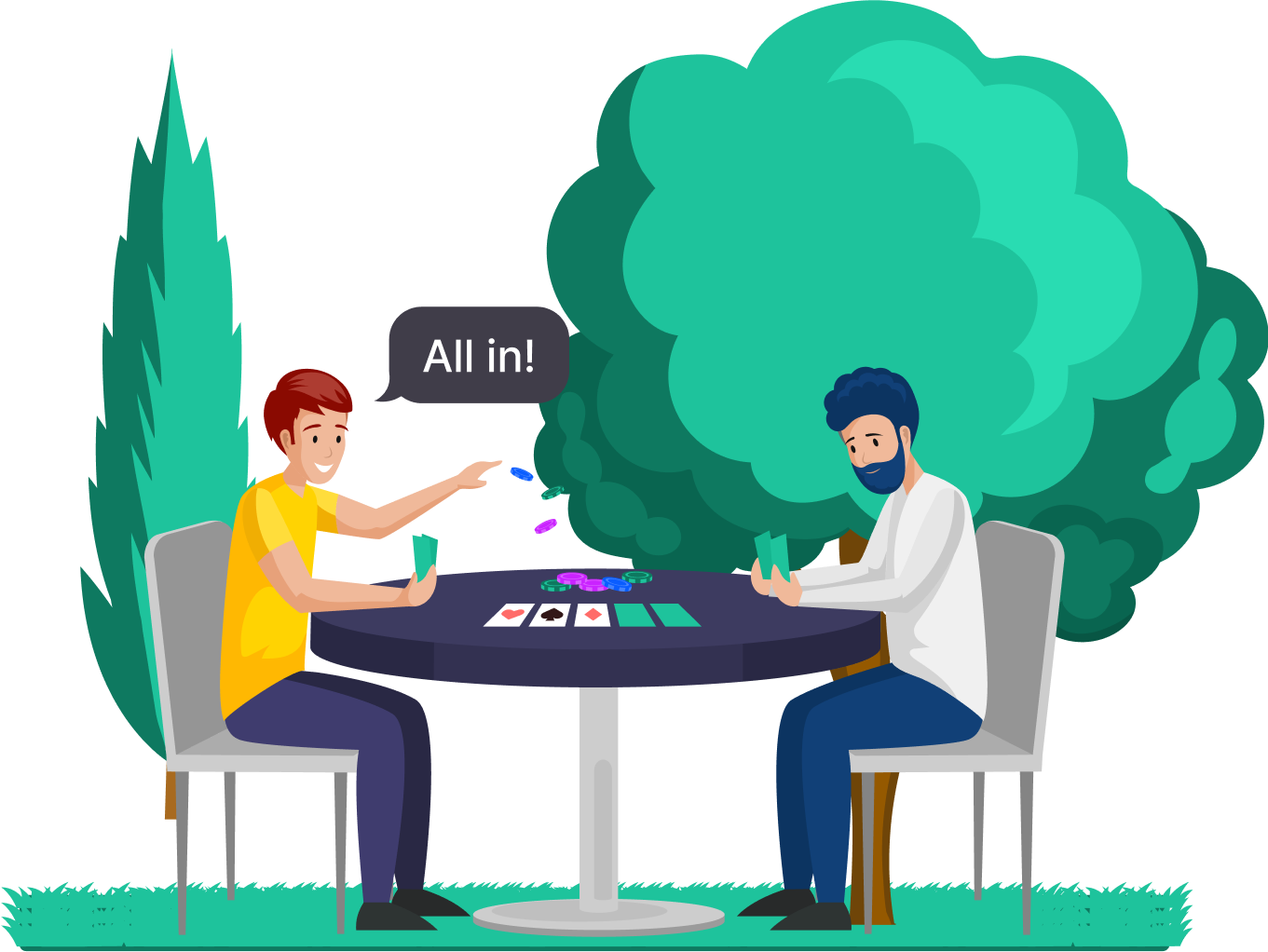
One crucial factor a solver will not consider, that you absolutely should, is the skill differential between you and your opponent. Playing post-flop from out of position is always difficult, but it is especially hard against a strong opponent. For any of these hands where the EV is close, even those BB never shoves at equilibrium; shoving is still a viable option against a tough opponent. The EVs of calling or three-betting smaller depend heavily on your ability to realize equity after the flop, so when that’s in doubt, shoving becomes relatively more appealing.
Other important considerations include how wide you believe the BTN to be opening and how much they raise. As noted above, the EV of shoving these hands depends not so much on how BTN responds to the shove, but rather, how wide they open in the first place. The goal of shoving something like 66 is to catch them with their hand in the cookie jar, so to speak. They simply won’t often have a hand better than 66, so your shove is +EV no matter how often they call or fold with worse.
As for the size of BTN’s open, it makes a big difference. A smaller raise offers better pot odds, which makes calling relatively more appealing. Here’s a nine-handed Chip EV simulation where the BTN opens 2.1bb instead of 2.3bb.
That small change in the BTN’s raise size (plus an extra ante in the pot) reduces BB’s shoving frequency by more than half! Even so, the EVs remain quite close, and the candidate hands the same. All the pairs 88 and below are candidates for shoving, even those which never shove at equilibrium. The EV of shoving 55 is 1.75bb, compared to 1.78bb for the smaller three-bet.
All those shoves are gone! Most of the hands that were previously shoving now play better as calls. This reflects a core tenet of the Independent Chip Model (ICM): ICM reduces the value of accumulating chips. Where the Chip EV model treats all chips as equally valuable, ICM treats your last chip as the most valuable and each additional chip added to your stack as slightly less valuable than the ones you already had. Thus, as ICM pressure increases, the value of winning 5bb when BTN folds to the shove is reduced, and the cost of elimination when BTN calls and wins increases.
ICM treats your last chip as the most valuable and each additional chip added to your stack as slightly less valuable than the ones you already had.
The EVs do not run as close here as in the Chip EV solutions. At equilibrium, shoving small pairs is roughly 20% worse than calling with them, so it would require some pretty egregious deviations to make shoving the better option. It’s noteworthy that BTN’s opening range becomes tighter as the tournament progresses and ICM pressure increases. BTN, too, values preservation more than accumulation.
The following chart shows how the BB’s response to a BTN open changes as the tournament progresses.
Chip EV is not a perfect model for tournament play even on the first hand, and you can see how these big shoves drop out of BB’s strategy as the bubble approaches. As we approach the bubble, shoves become smaller 3-bets, some 3-bets become calls, and some calls become folds.
Interestingly, as stronger and stronger hands shift out of BB’s 3-betting ranges into their calling range, BB folds less. The presence of those stronger hands in the calling range makes it harder for BTN to aggress after the flop, which in turn made it easier for BB to realize equity with some hands that were folding when BB employed a more aggressive 3-betting strategy.
The SB’s Response
We see a similar pattern with the SB, with the few 40bb shoves they have over a BTN open under the Chip EV model dropping off as ICM becomes a more significant factor.
The following table displays SB’s strategy facing a BTN open by tournament phase, 40bb deep.
Shallower Stacks
With 30bb stacks, the risk:reward ratio of shoving is more favorable and shoving remains part of the BB’s response to a BTN raise until very near the bubble. Even so, their shoving strategy becomes more conservative as the tournament progresses.
The following table displays BB’s strategy facing a BTN open by tournament phase, 30bb deep.
There are also some interesting changes to the composition of BB’s shoving range as the tournament progresses. Medium pairs start to play better as calls, while suited Ks and Qs actually shove a bit more aggressively. Below is a side-by-side comparison of BB’s shoving range vs a BTN open with 30bb stacks with 25% of the field remaining and with 50% of the field remaining.
This corresponds to a change in the BTN’s range for calling the shove, shown in the charts below. As BTN folds more suited K♠ and small pairs, BB has less incentive to shove medium pairs and more incentive to shove smaller suited K♠.
Squeezing
The same patterns mostly persist in BB’s shoving strategy after SB calls BTN’s open. With more chips and a third player in the pot, shoving remains part of BB’s response right up to the bubble. As the tournament progresses, however, BB swaps out of some of those shoves for smaller 3-bets, just as in a heads up scenario.
On the bubble, BB’s shoving frequency actually goes back up a bit from when 25% of the field remained. This does not reflect BB shoving weaker hands; their total three-betting frequency is at its lowest on the bubble. Rather, TT, JJ, and AKo, which earlier in the tournament preferred to induce action with a smaller squeeze, have more incentive to shove and take the pot down with less risk on the bubble.
It’s also interesting to note that while BB’s folding frequency in heads up pots actually goes down on the bubble, thanks to the protection of stronger hands in the calling range, their folding frequency continues to rise after SB calls. Multiway pots exacerbate the effects of ICM. Better pot odds mean BB wins larger pots when they win, but winning is harder with more players in the pot. ICM encourages BB to value protecting the chips they have over accumulating more chips.
Conclusion
ICM punishes risk-taking. The closer you are to the bubble, the more you should strive to conserve your chips and avoid situations where your survival is at risk. Consequently, big shoves over late position steals become less desirable as the tournament progresses. When you do shove, such as when stacks are shallower or a third player is in the pot, the hands you shove are stronger. Hands as strong as AKo and JJ prefer shoving to win a smaller pot with less risk over the high-risk, high-reward strategy of three-betting smaller to induce action.
Author
Andrew Brokos
Andrew Brokos has been a professional poker player, coach, and author for over 15 years. He co-hosts the Thinking Poker Podcast and is the author of the Play Optimal Poker books, among others.
